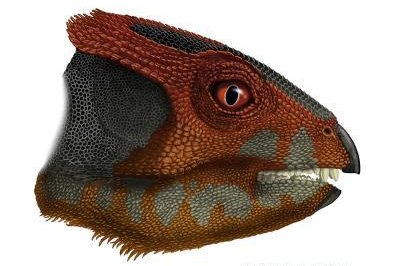Hualianceratops wucaiwanensis stood on its hind feet and wasn't much bigger than a cocker spaniel. Photo by Portia Sloan Rollings
WASHINGTON, Dec. 9 (UPI) -- In a paper published this week in the journal PLOS ONE, researchers have described a new plant-eating dinosaur species, Hualianceratops wucaiwanensis.
The species is an early Triceratops relative, one of two ceratopsians discovered by the same team of researchers. In 2002, paleontologists James Clark of George Washington University and Xu Xing from the Chinese Academy of Sciences named the oldest of the "horned dinosaurs" family Yinlong downsi.
Though Yinlong downsi and Hualianceratops wucaiwanensis are members of the horned dinosaurs family, neither boast horns.
The newly named Hualianceratops wucaiwanensis was a slightly shorter, chunkier version of Yinlong downsi. The species stood on its hind legs and wasn't much bigger than a cocker spaniel.
Researchers were able to reconstruct the dinosaur's body type based on partial skull and foot fossils found in China. Both ceratops species were found in the same fossil beds in Xinjiang Province.
"Finding these two species in the same fossil beds reveals there was more diversity there than we previously recognized," study co-author Catherine Forster, professor of biology with George Washington's Geological Sciences Program, said in a press release. "It suggests that the ceratopsian dinosaurs already had diversified into at least four lineages by the beginning of the Jurassic Period."
Hualianceratops wucaiwanensis grazed the grasses of ancient China some 160 million years ago, during the early part of the Late Jurassic Period. The new fossils suggests several ceratopsian lineages lived side by side during the period.
"Identifying Hualianceratops allows us to expand the beaked family of dinosaurs, Ceratopsia, which includes popular species like Triceratops and Psittacosaurus," added lead study author Fenglu Han, a postdoctoral researcher with the School of Earth Sciences at China University of Geosciences. "Now we know the horned dinosaurs thrived in the early Late Jurassic, and they co-existed with Guanlong, which was an early relative of T. rex and maybe threatened them."















